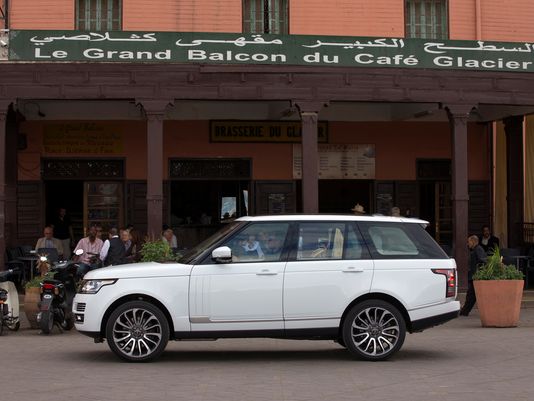Test Drive: Range Rover, come over
It's risky to tackle an icon. The "improvements" might ruin it.
Land Rover wins applause for having the courage to redesign its flagship Range Rover, and a standing ovation for the way the 2013 Range Rover's overhaul came out.
Because of its ability to do about everything well, and the tasteful way it wraps you in almost overwhelming luxury, you're forgiven if you decide the new Range Rover is the most desirable vehicle on the road.
Yes, it's a ton of money — $83,500 to start, and you won't find one that cheap. Between the common options and the common dealer markups, figure $90,000 or so is the floor.
If the standard model's 375-horsepower V-8 seems insufficient, (it most certainly isn't, by the way) and you simply must have the 510-hp supercharged V-8, then the starting price is $99,950.
Add $10,000 or $20,000 in options and markups for real-world starting prices.
The new Range Rover, which went on sale in December, is popular worldwide, and supplies are tight, thus the markups. If you're spending six figures for the family buggy, you don't want to see other Moms and Dads parking similar vehicles at the soccer pitch.
But never mind the upper-crust considerations. The Range Rover is wonderful to drive, no matter the size of your bank account.
The test vehicles were a non-supercharged model, well-furnished at about $95,000, and a likewise lavish $112,000 supercharged version.
The overhaul shed a stunning 700 pounds from the U.S.-market models, by switching from steel to aluminum for the body and some chassis components. The older model also had a heavy design — a unibody atop a frame, the auto equivalent of a belt and suspenders. Vehicles almost always are body-on-frame, or unibody, not both. The new Range Rover is simply unibody.
The makeover added more than four inches of rear legroom, which is why it's no longer absurd to think of the vehicle as a true, comfortable, five-passenger machine.
Some standard and optional features that contribute to the vehicle's high level of user satisfaction:
New suspension technology that provides a dreamy (not sloppy) ride, yet lets the tall, 5,000-pound SUV take corners with little body lean and as much control as a good sedan.
A slick-shifting eight-speed automatic transmission that complements the V-8s well.
All-wheel drive that you can leave in automatic forever, or use a console knob to choose settings for snow, mud or other challenges.
Outside mirrors that automatically fold so Range Rover's unusual girth isn't a hazard in parking lots.
A trim (for its size) 40-foot-diameter turning circle.
An automatic parking system that'll parallel park for you, then, uniquely, "unpark" when you're ready to leave.
Power closers that finish snugging the doors so you needn't slam or re-close if you push too lightly.
Power up-and-down not only for the lift gate but also the stubby, drop-down tailgate (handy as a seat for pulling on sports gear).
Supremely comfortable seats. Attractive, easy-to-read instruments.
There are flaws, of course.
Expect fuel consumption in the midteens overall. But remember, the engines are very powerful and are moving a two-and-a-half ton vehicle shaped more like a brick than a bullet.
At least, Rover says, you can burn lower-price regular fuel without hurting the engines (even the supercharged model) or voiding the warranty. Premium's recommended.
The infotainment system — or do we call it telematics now? — didn't play well with Test Drive's oh-so-hip Windows phone. Had to re-sync it several times. Sometimes, the vehicle would download the phone's contacts, sometimes, it wouldn't. Though the display said the music stored on the phone was connected, the vehicle instead played from a mysterious hidden playlist of its own.
The navi took too long to recalculate after a missed turn. It lagged reality, not signaling a turn until you were almost past.
Here's an odd one. The redesign lowered the roof a little — 0.8 of an inch — for looks and better airflow. But combined with the Range Rover's traditional, upright, chair-style seating position, taller drivers can have to twist and duck a bit to avoid noggin-knocking when getting in. Happens routinely in low-slung sports machines, but unheard-of in tall SUVs.
Gripes are glaring, but worth overlooking, because they're in one of the best-executed, nicest-driving, most-powerful vehicles on the road.
What? Full remake of Land Rover's flagship: Four-door, five passenger, all-wheel drive, high-performance, luxury SUV.
When? On sale since December.
Where? Made at Solihull, England.
How much? $83,500 to $135,750, including $850 shipping. Expect dealer markups because of tight supply.
What makes it go? 5-liter V-8 rated 375 horsepower at 6,500 rpm, 375 pounds-feet of torque at 3,500 rpm. Optional: Supercharged 5-liter V-8 rated 510 hp at 6,000, 461 lbs.-ft. at 2,500. All with all-wheel drive, eight-speed automatic.
How big? Similar footprint to a full-size sedan. Range Rover is 196.8 inches long, 78.1 in. wide, 72.3 in. tall on 115-in. wheelbase.
Weighs 4,850 lbs. (5,137 lbs., Supercharged). Cargo space under luggage cover, 19.4 cubic feet. Behind second row without cover, 32.1 cu. ft. Second row flat, 71.7 cu. ft. Turning circle diameter, 40.4 ft. Tows up to 7,716 lbs.
How thirsty? Rated 14 mpg in the city, 20 mpg highway, 16 in city/highway mix. Supercharged: 13/19/15.
Trip computer in non-supercharged tester registered 19.8 mpg (5.05 gallons per 100 miles) in fast highway driving. Supercharged registered 12.8 mpg (7.81 gal./100 mi.) in spirited suburban driving.
Burns premium, holds 27.7 gallons.
Overall: If you have the dough, no reason to say no.










